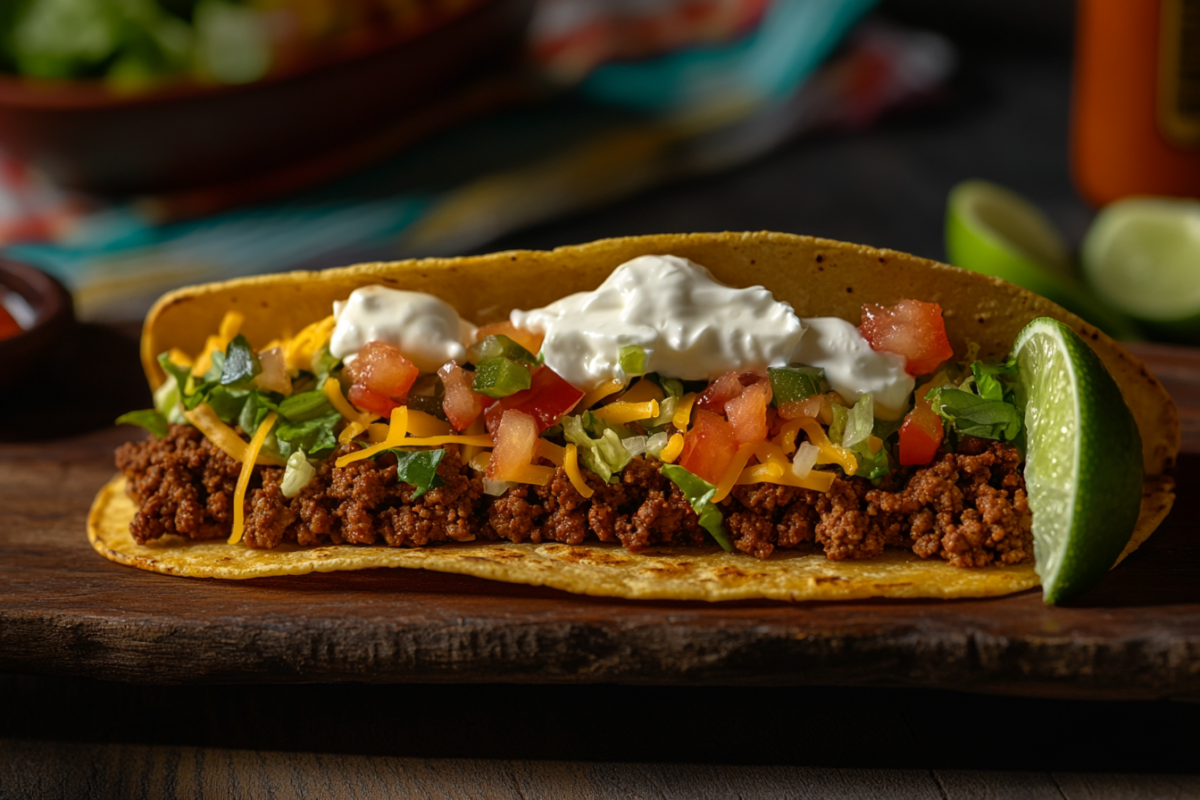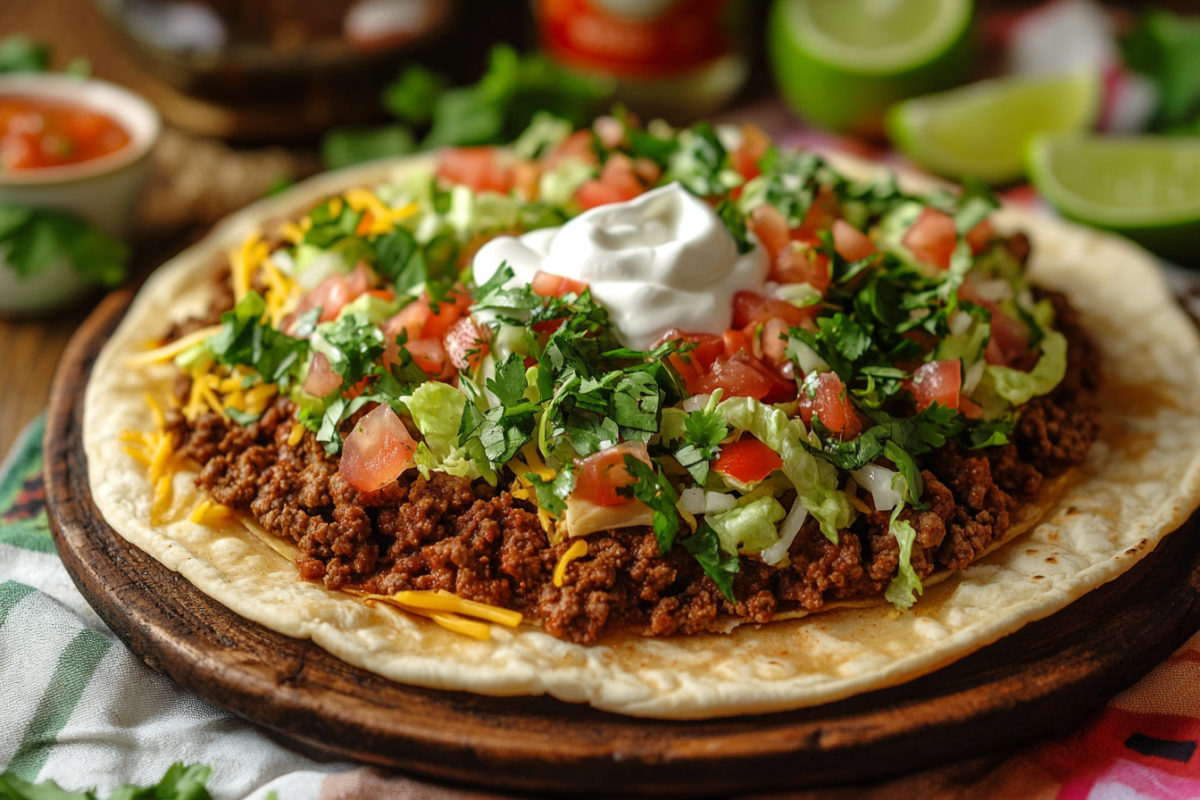Ground beef, or minced beef, is a staple in kitchens around the world. Whether it’s the star of a hearty burger, part of a savory taco filling, or a key ingredient in comforting meatloaf, ground beef is incredibly versatile. It’s easy to cook, affordable, and can be used in a variety of dishes that suit any occasion.
In this comprehensive guide, we’ll take a deep dive into everything you need to know about ground beef. From its nutritional benefits and how to choose the best cuts to mouthwatering recipes, we’ve got you covered. Plus, we’ll share expert tips on how to cook ground beef to perfection and ensure your dishes are always full of flavor. So, whether you’re a seasoned home cook or just starting, this guide will help you make the most out of ground beef in your kitchen.
What is Ground Beef?
Ground beef is exactly what it sounds like—beef that has been minced or ground to a fine texture. This process involves grinding cuts of beef (often from tougher parts of the cow) using a meat grinder or food processor. You can find ground beef in a range of fat contents, from lean ground beef to fattier versions, giving you plenty of options to suit your needs.
In addition to being affordable, ground beef is packed with protein, making it a nutritious choice for those looking to fuel their day with healthy, muscle-building meals. But what makes it stand out is its incredible versatility in the kitchen. You can use it in everything from simple weeknight dinners to gourmet recipes.
Health Benefits and Nutritional Facts
Nutritional Breakdown
When it comes to ground beef, it’s not just about great taste—it’s also packed with nutrients. Let’s break it down:
Protein: One of the standout features of ground beef is its high protein content. A 3-ounce serving of cooked lean ground beef typically offers around 22 grams of protein, which is essential for building and repairing muscles. This makes it an excellent choice for those aiming to increase their protein consumption.
Fat: While ground beef does contain fat, the amount varies depending on the cut. Leaner versions, such as extra-lean ground beef, have less fat, while fattier cuts (like 80% lean) are higher in saturated fat. Fat plays a vital role in your body, helping absorb fat-soluble vitamins and providing energy.
Carbs: The great news is that ground beef is virtually carb-free. This makes it a great choice for low-carb or ketogenic diets.
In addition to these macronutrients, ground beef is also a rich source of essential vitamins and minerals. It’s loaded with iron, which is vital for red blood cell production; B12, crucial for nerve function and energy production; and zinc, which supports immune health. These nutrients make ground beef an excellent addition to a balanced diet.
Is Ground Beef Healthy?
So, is ground beef actually healthy? The answer depends on the type of ground beef you choose and how you incorporate it into your overall diet.
- Lean vs. Fatty Ground Beef: Lean ground beef (such as 90% lean or higher) contains less fat and fewer calories, making it a healthier option for people watching their weight or trying to reduce fat intake. On the other hand, fattier cuts like 70% lean ground beef are higher in saturated fat, which, when consumed in excess, can contribute to heart disease. However, fat in moderation is necessary for your body’s function, so it’s all about balance.
- Role in a Balanced Diet: Ground beef can absolutely be part of a balanced diet. It provides protein, vitamins, and minerals that support overall health. When consumed alongside fruits, vegetables, and whole grains, it helps create a well-rounded meal.
- Health Considerations: People with specific dietary restrictions, such as those with heart disease or high cholesterol, should be mindful of the fat content in ground beef. Opting for leaner cuts and preparing it in healthier ways, like grilling or baking, can help keep your meals heart-healthy. For those following a vegetarian or vegan diet, plant-based ground beef alternatives are also available and can provide a similar texture and flavor.
Buying Ground Beef – What to Look For
How to Choose the Best Ground Beef
When shopping for ground beef, the first thing to consider is the quality. Here’s how to select the best option:
- Labels to Look For: If you’re after high-quality ground beef, check for labels like “grass-fed” or “organic.” Grass-fed beef tends to have a healthier fat profile, with more omega-3 fatty acids, and may also be lower in total fat. Organic options come from cattle that are raised without synthetic hormones or antibiotics, offering a more natural choice for your meals.
- Meat Color and Fat Content: Fresh ground beef should have a bright red color on the outside with a darker interior. If it’s turning brown, it may not be as fresh. For fat content, leaner cuts such as 90% lean or higher are ideal if you’re aiming to reduce fat intake, while cuts like 80% lean offer a richer flavor but higher fat content. Keep in mind, the higher the fat percentage, the juicier and more flavorful the meat tends to be.
Ground Beef Price – Is it Worth the Cost?
Now, let’s talk about the price. Beef can vary widely in cost, depending on the type and quality you’re buying.
- Factors That Influence Beef Prices: Factors such as whether the beef is grass-fed, organic, or conventionally raised will impact its price. Grass-fed or organic options tend to cost more, but many people find the extra expense worthwhile for the higher quality and ethical considerations. Additionally, leaner cuts generally cost more than fattier varieties.
- Where to Find the Best Deals: To get the most value for your money, shop around. Local farmers’ markets can offer grass-fed options at competitive prices. Large grocery chains often run sales, so it’s worth keeping an eye out for discounts. Buying in bulk can also help lower the cost per pound—just make sure to freeze any excess if you’re not using it right away.
How to Cook Ground Beef

Best Cooking Methods
Cooking ground beef can be simple and versatile, and there are several methods to choose from depending on your dish and preferences. Here are the most popular ways to cook it:
- Pan-Frying: One of the quickest and easiest methods, pan-frying involves cooking the beef in a hot pan. This method is great for dishes like tacos, spaghetti Bolognese, and burgers. Simply heat a bit of oil in the pan, add the beef, and cook over medium-high heat, breaking it apart as it cooks. Pan-frying gives you that crispy, caramelized flavor that’s hard to beat.
- Grilling: Grilling is perfect for making burgers. Form the beef into patties, season as desired, and grill them on a preheated grill. The high heat seals in the juices, giving the meat a nice char on the outside while keeping it tender inside. It’s an ideal method for a smoky flavor.
- Slow Cooking: For a tender and flavorful result, slow cooking is the way to go. This method is perfect for stews, chili, and meat sauces. Brown the beef first in a pan, then add it to the slow cooker with the other ingredients. The slow cooking method lets the flavors blend harmoniously.
- Baking: Baking is great for casseroles or dishes like meatloaf. Once browned, mix the beef with other ingredients, then bake in the oven at a moderate temperature until fully cooked. This method requires minimal hands-on time and is convenient for meal prep.
How to Prevent Ground Beef from Becoming Greasy
No one likes a greasy dish, but it’s common with fattier cuts. Here’s how to avoid that greasy texture:
- Tips for Draining Excess Fat: After cooking, use a slotted spoon to transfer the beef from the pan. Tilt the pan and let the fat drain off, or blot with a paper towel. This helps keep the dish lighter.
- Using Leaner Cuts: Opt for leaner cuts like 90% lean or extra-lean beef. Though less juicy, this helps reduce the greasy texture. If you’re using fattier cuts, be sure to drain the excess fat as soon as possible.
Cooking Temperatures
Ensuring proper cooking temperature is essential for safety and flavor:
- Safe Cooking Temperatures: The USDA recommends cooking beef to an internal temperature of 160°F (71°C) to ensure harmful bacteria are killed. For burgers, use a meat thermometer to check the center. This is crucial with ground beef as it’s more prone to harboring bacteria than whole cuts.
- Tips for Ensuring Doneness: If unsure, cut into the meat to check for doneness. The beef should be brown throughout, with no pink spots. Avoid overcooking to keep it from becoming dry. If preparing larger dishes like meatloaf, ensure the thickest part is fully cooked.
Popular Ground Beef Recipes
Easy Ground Beef Recipes for Dinner
If you’re looking for simple, delicious meals to make with minced beef, these classic recipes are sure to please everyone at the table:
- Classic Beef Tacos: Tacos are a quick and easy dinner that never disappoints. Start by browning minced beef in a skillet, then add taco seasoning (or make your own with cumin, paprika, garlic powder, and chili powder). Once the meat is cooked, fill taco shells with the seasoned beef and top with your favorite toppings like lettuce, cheese, sour cream, and salsa. You can even make it a taco bar and let everyone customize their own!
- Spaghetti Bolognese: This rich and hearty pasta dish is a family favorite. Brown minced beef with onions, garlic, and herbs, then simmer in a tomato sauce until the flavors meld together. Serve it over a bed of spaghetti and garnish with Parmesan cheese. It’s perfect for a cozy weeknight dinner, and the leftovers taste even better the next day!
- Beef Burgers: A classic American favorite, beef burgers are simple to make and always satisfying. Season the minced beef with salt, pepper, and any other seasonings you like (garlic powder, onion powder, or Worcestershire sauce all add a great flavor). Form into patties and grill or pan-fry them. Serve on a toasted bun with lettuce, tomato, and your favorite condiments for a delicious meal.
Creative Ways to Use Ground Beef
Looking to get a bit more creative with your minced meat? Here are some fun and tasty ideas to add some variety to your meals:
- Ground Beef in Soups and Stews: Minced beef is a great addition to soups and stews. It adds heartiness to dishes like chili, beef and vegetable soup, or a classic beef stew. Simply brown the meat and add it to your broth with vegetables, beans, and seasonings. Let it simmer until the flavors come together, and you’ll have a warm, satisfying meal that’s perfect for chilly days.
- Beef Casseroles and Stuffed Vegetables: Casseroles are a great way to use minced beef and feed a crowd. Try a beef and potato casserole, or stuff bell peppers with the beef, rice, and spices, then bake them until tender. These dishes are great for feeding a large family or preparing in advance for a busy week.
- Meat as a Filling for Pies and Pastries: Ground beef works wonderfully as a filling for savory pies or pastries. A classic example is meat pie, where minced meat is cooked with onions, garlic, and seasonings, then wrapped in a flaky pastry crust and baked to golden perfection. You can also use it as a filling for pasty pockets or empanadas for a fun, portable meal.
Meal Prep Ideas Using Ground Beef
Minced beef is also an excellent choice for meal prep. Here are a few ideas to help you get ahead in the kitchen:
- Tips for Preparing Meals Ahead of Time: When meal prepping with minced beef, start by cooking large batches of your favorite dishes like tacos, chili, or meat sauce. Store the cooked meat in airtight containers in the fridge, so you can easily assemble meals throughout the week. This saves you time and energy when you’re short on time but still want a homemade meal.
- Storing Cooked Ground Beef for Later Use: After cooking your minced beef, let it cool before transferring it to storage containers. It’s best to store it in the fridge for up to 3-4 days or freeze it for longer storage. You can portion it out into smaller servings, which makes it easy to grab when you’re ready to cook. Be sure to heat it thoroughly before consuming.
Ground Beef and Its Role in Different Cuisines
International Cuisines
Ground beef is used in various ways across the globe, playing an essential role in many cuisines. Let’s take a look at how different cultures incorporate this versatile ingredient into their dishes:
- Mexican Cuisine: In Mexico, this ingredient is often used in dishes like tacos, burritos, and enchiladas. Seasoned with spices like cumin, chili powder, and garlic, it takes on a rich, savory flavor. Whether it’s used as a filling for tacos or stuffed into burritos with beans and cheese, it’s a flavorful and filling option in Mexican cuisine.
- Italian Cuisine: Italy is famous for its use of ground beef in dishes like spaghetti Bolognese, meatballs, and lasagna. The beef is typically simmered with tomatoes, garlic, onions, and herbs to create a savory, rich sauce. Italian meatballs are often combined with breadcrumbs, Parmesan cheese, and herbs, then baked or fried to create a delicious, juicy bite.
- American Cuisine: In the United States, ground beef is synonymous with burgers and meatloaf. Whether it’s grilled up into a juicy burger or baked into a comforting meatloaf, it’s at the heart of many American classics. It’s often paired with ketchup, mustard, and other condiments to create a tasty, satisfying meal.
Regional Variations of Ground Beef Dishes
Ground beef varies not only by cuisine but also by region. Different parts of the world use it in unique ways, influenced by local ingredients and cultural tastes:
- How It’s Used in Different Parts of the World: In India, the meat is often seasoned with curry spices, while in the Middle East, it’s used in dishes like kebabs and koftas. In the Balkans, it’s often combined with rice and herbs to make savory stuffed peppers or cabbage rolls. The versatility of ground beef makes it adaptable to many different flavor profiles and cooking techniques.
- Cultural Influences on Recipes: Regional influences, like the Mediterranean’s love for olive oil and herbs or the smoky flavors in Southern barbecue, shape how it’s used. These cultural variations offer endless possibilities for incorporating this versatile meat into your meals, giving you the chance to explore new tastes and textures.
Storing and Handling Ground Beef
Proper Storage for Fresh and Cooked Beef
When it comes to storing this meat, ensuring that it’s kept fresh and safe to eat is crucial. Here are some key tips:
- Best Practices for Refrigerating and Freezing: The meat should be stored in an airtight container or tightly wrapped in plastic wrap or foil if you plan to refrigerate it. Keep it in the coldest part of the fridge, and try to use it within 1-2 days. If you’re not using it right away, freezing is the best option. For freezing, store it in a heavy-duty freezer bag or container, and it can last up to 3-4 months.
- How Long It Lasts in the Fridge: Fresh ground beef typically lasts 1-2 days in the fridge before it starts to spoil. If you’re unsure about its freshness, check for any off smells or a slimy texture, which are signs it’s no longer good.
- Tips for Thawing Frozen Beef Safely: When you’re ready to use frozen beef, always thaw it safely in the fridge overnight or use the defrost setting on your microwave. Never thaw it on the counter, as this can allow bacteria to grow.
Questions
- How do I know if it’s bad? If your ground beef has a sour or off smell, changes color to brown or gray, or has a slimy texture, it’s likely spoiled and should be discarded.
- Can I use it in place of other meats? Yes! Ground beef can be substituted for ground turkey, chicken, or pork in many recipes, though it may change the flavor and texture slightly.
- How can I make it less greasy? To reduce the greasiness, drain the excess fat after cooking and use leaner cuts. Alternatively, you can also blot the cooked meat with paper towels to soak up extra grease.
- Can I freeze cooked meat? Absolutely! Cooked ground beef freezes well. Just let it cool down, then store it in an airtight container or freezer bag. You can be stored in the freezer for three months. When ready to use, reheat it thoroughly in a pan or microwave.

